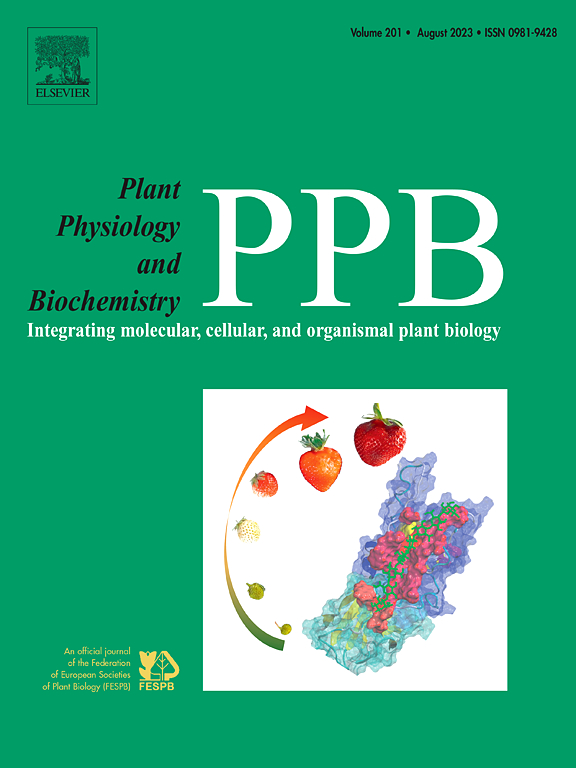The GmbHLH13-GmCHS7 module positively regulates isoflavones accumulation in soybean (Glycine max. L)
IF 5.7
2区 生物学
Q1 PLANT SCIENCES
引用次数: 0
Abstract
Isoflavonoids are widely regarded as phytoalexins and plant estrogens, with applications in plant defense and human healthcare. However, the mechanism of soy isoflavone synthesis remains unclear. In this study, we identified a gene from Glycine max, designated as basic helix-loop-helix 13 (GmbHLH13), which is a member of the bHLH transcription factor family. Overexpression of GmbHLH13 significantly enhanced the accumulation of isoflavonoids in soybean seeds. A combined analysis of the transcriptome and metabolome showed that GmbHLH13 enhanced the expression of multiple genes in the phenylpropanoid metabolism pathway, leading to increased production of downstream metabolites. We established that GmbHLH13 interacted with GmMYB12B2 and GmWD40-7 to form a MYB-bHLH-WD40 (MBW) complex that binded directly to the promoter region of GmCHS7, further increasing GmCHS7 expression. In addition, GmbHLH13 alone or complexed with GmMYB12B2 or GmWD40-7, positively regulated GmCHS7 expression, however, the effect was lower than that of the MBW complex. The findings of this study provide a valuable genetic breeding resource and gene for improving soybean varieties with high isoflavone content.
GmbHLH13-GmCHS7模块正调控大豆(Glycine max.)异黄酮积累。L)
异黄酮被广泛认为是植物抗毒素和植物雌激素,在植物防御和人体保健方面具有广泛的应用。然而,大豆异黄酮的合成机制尚不清楚。在这项研究中,我们从Glycine max中鉴定了一个基因,命名为basic helix-loop-helix 13 (GmbHLH13),它是bHLH转录因子家族的成员。过表达GmbHLH13显著促进大豆种子中异黄酮的积累。转录组和代谢组的联合分析表明,GmbHLH13增强了苯丙素代谢途径中多个基因的表达,导致下游代谢物的产生增加。我们发现GmbHLH13与GmMYB12B2和GmWD40-7相互作用形成MYB-bHLH-WD40 (MBW)复合物,直接结合到GmCHS7的启动子区域,进一步增加GmCHS7的表达。此外,GmbHLH13单独或与GmMYB12B2或GmWD40-7配合均可正向调节GmCHS7的表达,但其作用低于MBW复合物。本研究结果为大豆高异黄酮含量品种的改良提供了宝贵的遗传育种资源和基因。
本文章由计算机程序翻译,如有差异,请以英文原文为准。
求助全文
约1分钟内获得全文
求助全文
来源期刊
CiteScore
11.10
自引率
3.10%
发文量
410
审稿时长
33 days
期刊介绍:
Plant Physiology and Biochemistry publishes original theoretical, experimental and technical contributions in the various fields of plant physiology (biochemistry, physiology, structure, genetics, plant-microbe interactions, etc.) at diverse levels of integration (molecular, subcellular, cellular, organ, whole plant, environmental). Opinions expressed in the journal are the sole responsibility of the authors and publication does not imply the editors'' agreement.
Manuscripts describing molecular-genetic and/or gene expression data that are not integrated with biochemical analysis and/or actual measurements of plant physiological processes are not suitable for PPB. Also "Omics" studies (transcriptomics, proteomics, metabolomics, etc.) reporting descriptive analysis without an element of functional validation assays, will not be considered. Similarly, applied agronomic or phytochemical studies that generate no new, fundamental insights in plant physiological and/or biochemical processes are not suitable for publication in PPB.
Plant Physiology and Biochemistry publishes several types of articles: Reviews, Papers and Short Papers. Articles for Reviews are either invited by the editor or proposed by the authors for the editor''s prior agreement. Reviews should not exceed 40 typewritten pages and Short Papers no more than approximately 8 typewritten pages. The fundamental character of Plant Physiology and Biochemistry remains that of a journal for original results.

 求助内容:
求助内容: 应助结果提醒方式:
应助结果提醒方式:


